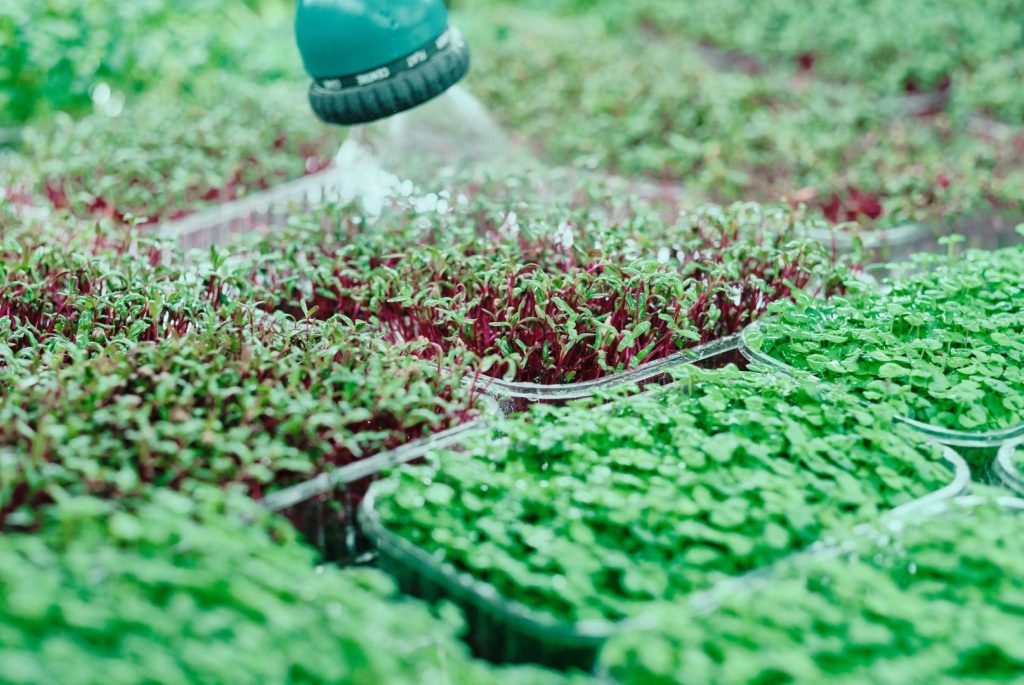From seed to super-food – Exploring the world of Microgreens
What are Microgreens?
Microgreens are young, tender, and edible seedlings of various vegetables and herbs. They are harvested just after the cotyledon leaves (the first leaves that appear during germination) have developed. Typically, microgreens are harvested when 2.5-7.5 cm (1 to 3 inches) tall and have a more intense flavor than mature plants.
Microgreens come in various colors, textures, and flavors, often used to enhance the visual and taste appeal of dishes. Popular microgreens include radish, broccoli, arugula, kale, cilantro, swiss chard, beetroot, mustard, wasabi, and many others. They are commonly used in salads, sandwiches, wraps, and garnishes for various dishes.
These tiny greens are not to be confused with sprouts, germinated seeds typically consumed with the seed, root, and shoot still attached.
How and where can microgreens be grown?
Microgreens can be grown both indoors and outdoors. Nowadays, these are being grown commercially on a large scale to meet the rising demand in the HORECA domain.
Materials required for sowing – What you may need for sowing microgreens
Seeds: Select seeds of vegetables or herbs suitable for microgreens, which means their germination percentage should be more than 90% so that even after germination loss, the aesthetic view of the microgreens is not lost. Popular choices include broccoli, radish, kale, arugula, cilantro, and mustard.
Growing Medium: Use a high-quality potting mix or a soilless medium like coco peat, peat moss, or a combination of both. Mediums with good moisture absorption capacity, such as coco peat, should be preferred.
Containers: Trays or shallow containers with drainage holes work well. You can also use specialized microgreen trays, which are available in the market, or e-commerce stores like Amazon.
Light Source: Microgreens need plenty of light for healthy growth. Natural sunlight or artificial lights, such as fluorescent or LED grow lights, can be used. Adequate sunlight in the initial days helps in the prevention of lanky seedlings.
Watering Can or Spray Bottle: Microgreens need consistent moisture. A gentle watering can or spray bottle keeps the soil evenly moist.
Method of sowing
Sowing of Microgreens includes a few simple steps:
Prepare the Growing Medium:
Fill the trays or containers with the growing medium, leaving about 1-2 inches of space from the top.
Sow the Seeds:
Sprinkle the seeds evenly over the surface of the soil. You want a dense but not overcrowded layer of seeds. Try to leave some space near the corners of the containers so that when the seedlings grow, they are not overcrowded and push the corner seedlings outside.
Cover and Water:
Lightly press the seeds into the soil with a flat surface, and then cover them with a thin layer of soil or vermiculite.
Water the seeds gently, ensuring the soil is consistently moist.
Germination/ Incubation period
Once the sowing is done, move the sown trays to the incubation chamber or Germination room for incubation; this is generally preferred in farms where microgreens are grown on a large scale.
Based on the seed type, most microgreens usually take 2-5 days for germination.
Once the seeds start sprouting, shift the trays to the nursery house for further growth.
Nursery phase
Once Microgreens are in the nursery, light and irrigation are the two main requirements for their growth.
Provide Light:
Place the trays in a location with ample light. If using artificial lights, keep them about 2-4 inches above the seedlings.
Monitor and Water:
Keep an eye on the moisture level. Water the microgreens when the soil surface begins to dry out.
Try not to overwater them; upon continuous irrigation and high moisture levels in the medium, there is a high chance of wilt of fungal attack.

Harvesting microgreens
Microgreens are generally harvested when they are in the 2-leaf stage or when they are in a height of 2.5-7.5 cm (1-3 inches).
Scissors are used to cut the microgreens above the soil level.
Health benefits of microgreens – Are microgreens healthy?
Microgreens are not only colorful and flavorful but also have numerous health benefits. Here are some benefits of adding microgreens to our diet.
- Nutrient Density:
Microgreens are harvested at an early stage of growth and packed with many nutrients. Despite their small size, they are more concentrated in vitamins, minerals, and antioxidants compared to their mature counterparts.
- Rich in Antioxidants:
Antioxidants help protect the body from oxidative stress and inflammation. Microgreens, especially red cabbage and cilantro, are rich in antioxidants that may contribute to overall health.
- High in Vitamins and Minerals:
Microgreens are an excellent source of vitamins and minerals, such as vitamin C, vitamin K, and potassium. These nutrients are important for various bodily functions, including immune function, blood clotting, and heart health.
- Support Heart Health:
Some microgreens, like broccoli, contain compounds that may have cardiovascular benefits, such as reducing cholesterol levels.
- Potential Cancer-Fighting Compounds:
Certain microgreens, such as broccoli and radish, contain compounds that have been studied for their potential anti-cancer properties.
- Improves Digestive Health:
Microgreens, like arugula and cilantro, may contain fiber that can support digestive health by promoting regular bowel movements and a healthy gut microbiome.
- Low in Calories:
Microgreens are low in calories but high in nutrients, making them a nutrient-dense addition to meals without significantly increasing calorie intake.
- Versatility in Culinary Use:
Microgreens add texture, color, and flavor to dishes. Their versatility makes it easy to incorporate them into salads, sandwiches, wraps, smoothies, and various other recipes.
- Easy to Grow at Home:
Growing microgreens at home is a cost-effective way to have a fresh supply of nutrient-rich greens. They can be grown on windowsills, balconies, or countertops.
- Environmental Benefits:
Growing microgreens at home or on a small scale require less space and resources than growing mature vegetables. This can contribute to sustainability efforts.










































































